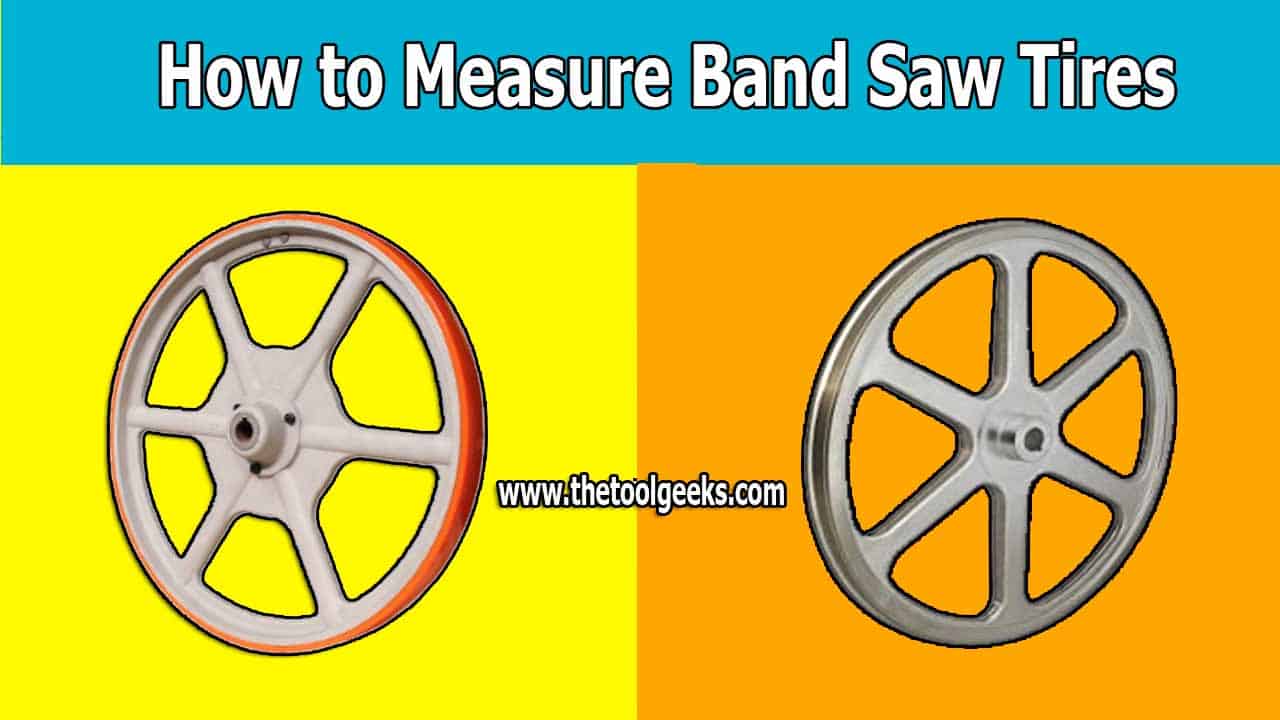How to Measure Band Saw Tires: Learn How To Install Them
TheToolGeeks.com is a participant in the Amazon Services LLC Associates Program and other affiliate advertising programs. We may earn from qualifying purchases. (Learn More).
Measuring your band saw tires is a relatively easy task to do.
The desired tire will typically measure 2 inches less than the diameter of the machine you are operating. You can easily determine the size of your band saw wheel by measuring its diameter with measuring tape and subtracting the 2 inches from this total.
For example, if your band saw wheel is 20 inches, then you need an 18-inch tire. This will ensure your tire fits securely on your band saw wheel.
Just like the tires on your cars, it is important to replace them after some time of use. Over time, the tires on your bandsaw can develop cracks and start shedding chunks or develop a particularly deep groove down their center all of which can negatively impact the performance of your saw.
There are two common types of band saw tires on the market below, we will discuss each one and its advantages and disadvantages.
Different Types Of Bandsaw Tires
Rubber Band Saw Tires
Rubber band saw tires are harder to install. This can be a problem if you suffer from limited hand strength. Rubber band saw tires often are not as abrasion-resistant as urethane tires (which we will look more into next).
The other main issue with rubber band saw tires is the downtime required for the tire to dry. Generally, once adhesive is applied it can take upwards of 24 hours of downtime before you can use your bandsaw tire.
This downtime can be a big problem if you are running a professional shop. Lastly, if you live in a hot and dry climate, rubber is especially suspectable to dry rot which will cause your rubber tire to crack far more quickly. Lastly installing bandsaw tires require more supplies, such as clamps and adhesive.
Related Read — Best Vertical Bandsaws
Key points
- Less abrasion resistant
- Suspect able to dry rot
- Upwards of 24 hours downtime for drying
- Requires more supplies
- Harder to install
Urethane Band Saw Tires
Urethane tires have a few key advantages over the rubber tires; however, they can be a little pricier compared to rubber. Generally, they should cost an extra $6-$10 more per tire. However, the advantages of urethane tires in our opinion outweigh the extra cost.
The urethane tire is far easier to install and requires little extra materials for installing. This is especially good if you suffer from limited hand strength and don’t want to splash out on special adhesives. Additionally, urethane tires are more abrasion resistant, which means it should wear much more slowly than the rubber and last for longer.
Unlike rubber, urethane is also not prone to dry rot, which makes it an ideal band saw tire for those living in hot and dry climates.
Another key factor to take into consideration, particularly if you are running a professional shop is time. Urethane tires do not require any special adhesives to install.
Related Read — Best Battery Bandsaws
Key Points –
- Cost a little more but the added benefits are worth it
- Easier to install
- Requires fewer materials to install
- More abrasion resistant
- No downtime to use
- Not prone to dry rot
Related Read — How to Unfold Bandsaw Blades?
How to Install Rubber Band Tire on Saw
Preparation
Before you can start installing your new rubber tire or replacing a rubber tire with a urethane tire, you must first remove the old tire. To do this, get a flat head screwdriver and slip it right between the old tire and the wheel itself.
Begin to take the tire off the wheel. Generally, tires, especially rubber ones adhered to the wheel with adhesive. If this is the case, you will want to grab a scraper of some kind, such as a putty knife or old chisel, and commence taking the larger glue residue off.
If this does not do the trick, you can resort to using a powerful solvent like a lacquer thinner and just wipe it all away.
An essential step before you go ahead and begin to install the new tire is to make sure you wipe down the wheel with some denatured alcohol and allow it to dry. Do not skip this step if you have used a solvent prior to removing the glue.
If not done, the residue from the solvent you have used can actually prevent the new glue from adhering properly to your new tire.
After the denatured alcohol has completely dried and the wheel is clean, you are ready to start putting your new tires on.
Installation
You will need –
- Two clamps
- Some quarter-inch thick scraps to protect the tire
- Three-quarter inch pipe
Related Read — Different Types of Bandsaws?
Begin by mounting the tire on one side of the wheel and clamp it into place. Repeat the process on the opposite side of the wheel. Once both opposite sides of the tire are anchored, you can begin stretching the rest of the tire onto the wheel.
Once your tire is attached to the wheel, the next thing you will want to do is equalize the elasticity of the tire using a piece of three-quarter-inch pipe.
Pry the tire away from the wheel using a flat end screwdriver, and fit the pipe in. Then clamp the wheel upright on your bench and start rolling the pipe around the diameter of the wheel.
Tip – Add a piece of tape to the wheel to mark your starting point. So that you know when you have been all the way around.
Next comes the adhesive. The pipe will give you room to work while you spread the adhesive on the underside of the tire and the wheel. Work your way around the wheel again and spread the adhesive to the tire and wheel pressing the tire into place as you go.
If you find that the tire is correct in diameter but off in width, you can take a utility knife and just use the rim of the wheel as a guide and trim off the excess after it has dried.
How to Install Urethane Tire
You Will Need –
- Hot water under 120 degrees
- Dish Soap
- Clamp
Pour your hot water into a spare bucket. You must ensure that your water is not more than 120 degrees. This is because while the elasticity will increase, it will never go back down.
Household tap water should be fine. But if you are unsure, it does not hurt to check with a thermometer. Once you have checked the temperature of your water begin adding some dish soap into the water.
Submerge the entirety of the urethane tire into the water and let it sit for 5 minutes. After 5 minutes, carefully take the tire out.
You can now start clamping. Because urethane tires are more flexible and easier to apply, you will only need one clamp. Once your clamp is attached, simply start pulling the tire around the edges of the wheel. The only downtime you are looking at once the tire is on the wheel is allowing the tire to cool.
The Take-Away
Measuring a band saw tire is a simple thing to do. Remember, subtract 2 inches from the wheel and that will be the measurement you need.
While urethane tires are a little more on the expensive side compared to rubber tires, the pros of using them far outweigh the cons.
Amazon and the Amazon logo are trademarks of Amazon.com, Inc, or its affiliates.

